
Archibald Knox Tudric Pewter Clock Case with Abalone Inlay
An Archibald Knox Tudric pewter clock case, model 252, inlaid with abalone shell and enamel, copper chapter ring, stamped 0252 to vase, height 18 cm.

Hexagonal Arts & Crafts Copper Vases with Ruskin Cabochons
A pair of Arts & Crafts copper vases, the hexagonal ovoid bodies with Ruskin cabochons with embossed stylised framing, tall hexagonal necks with tapered handles, height 34 cm.
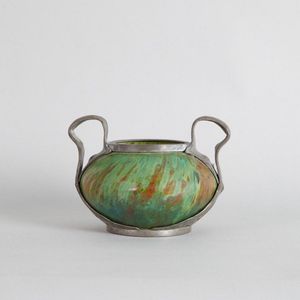
Art Nouveau Green Glass and Pewter Vase
An Art Nouveau Tudric glass and pewter vase, green glass with a squat form in a van Hauten two handled pewter mount, height 10.5 cm, width 18.5 cm, depth 16 cm
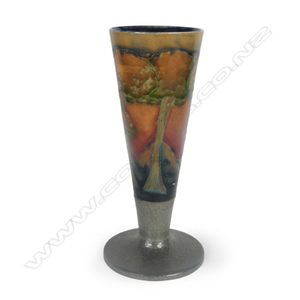
Moorcroft Eventide Vase with Tudric Pewter Base
A William Moorcroft Eventide pattern vase with Tudric pewter base, the flared trumpet form body on flared circular hammered pewter base with stamped Tudric and Moorcroft marks. Minor repair to rim. Height 18.6 cm.

Art Nouveau Pewter Vase by Archibald & Knox
An Art Nouveau pewter vase, c.1905 by Arichbald & Knox. Circular base with tapering cylindrical body and tendrils connecting the upper vase to the foot, height 36 cm, depth 16 cm
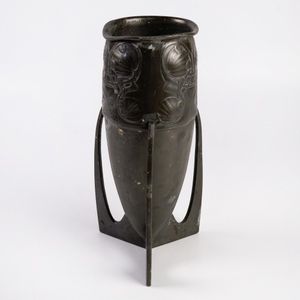
Tudric Pewter Bullet Vase by Archibald Knox (1910)
Liberty & Co Tudric pewter bullet vase designed by Archibald Knox circa 1910
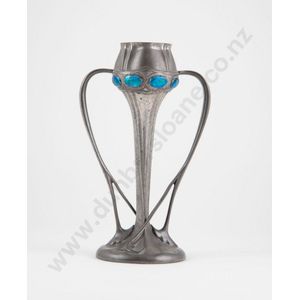
Tudric Pewter Vase with Turquoise Enamel by Archibald Knox
Archibald Knox for Liberty's Tudric pewter vase, tulip form with scrolling tendril handles and applied with turquoise enamel cabochons, design number 029, 25 cm high
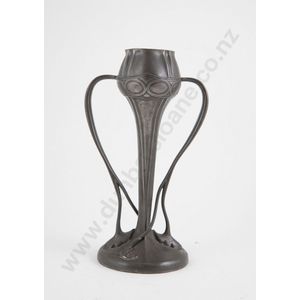
Knox's Tendril Pewter Vase for Liberty, c. 1905
Archibald Knox for Liberty's pewter vase, design no 0290 c1905 with scrolling tendril supports 26 cm height.

Archibald Knox Bullet Vase with Enamel Design
An English Pewter and enamel bullet vase, designed by Archibald Knox, model 0226 stamped marks. Height 18.5 cm.

Archibald Knox Tudric Pewter Vases with Enamel Roundels
Pair of vases Liberty & Co pewter Tudric, designed by Archibald Knox, model no. 0226 stamped mark, set with enamel roundels, height 19 cm, ( condition)
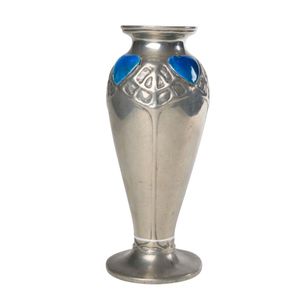
Archibald Knox Pewter Vase with Enamel Highlights
Posy vase Liberty & Co pewter Tudric, Celtic design, with enamel highlights, attributed to Archibald Knox, base stamp Tudric 0245W, height 20 cm, (good condition)
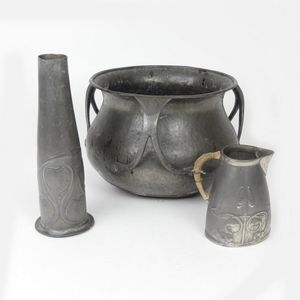
Faulted Tudric Pewter Pieces from Brian Coote Estate
Three pieces of Liberty & Co. Tudric pewter, a jardiniere 0337, a vase 0327 and a jug 0195, all variously faulted. Provenance: The Estate of Emeritus Professor Brian Coote CBE, FRSNZ (1929 - 2019)

Art Nouveau Pewter Vase with Archibald Knox Design
An English Pewter Art Nouveau vase, of circular shape with tall trumpet neck, two handles looped from mid-way on the neck and join the body in bifurcated tendrils which conjoin with an overhand knot motif. Impressed mark and no. 0214, attributed to…

Archibald Knox Tudric Pewter Vases with Whiplash Florals
Two Archibald Knox Tudric pewter vases, three handled bullet form, both decorated with whiplash florals, one with five enamel insets, a hole drilled in the side, the smaller missing the liner. Height 18.5 cm and 11.5 cm.

Art Nouveau Pewter Vases by Archibald Knox for Liberty
A pair of English pewter Art Nouveau Archibald Knox for Liberty vases, C.1902, embossed with his iconic traditional honesty plants, stamped pattern number 0226, height 19 cm
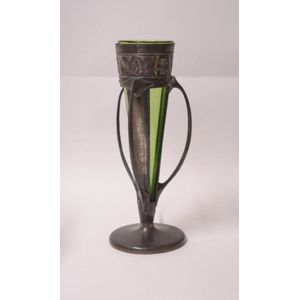
Archibald Knox Pewter Vase with Green Glass Liner
A Tudric pewter Archibald Knox design vase, narrow tapered form with three fine rib form curving handles, splayed base, the green glass liner by Powell, A.F. Height 22 cm

Archibald Knox Tudric Pewter Bombe Vase
A Tudric pewter Archibald Knox bombe form vase, shape #0226, three vertical ribs to the fin form feet. Height 19 cm

Art Nouveau Pewter Vases by Archibald Knox for Liberty & Co
A pair of pewter Art Nouveau vases of bullet shape, designed by Sir Archibald Knox for Liberty & Co. Height 14 cm

Tudric Pewter Jug Vases with Elongated Handles and Collar
David Veasey for Liberty & Co., rare pair of Tudric pewter jug vases with elongated side handles and rope work collar, impressed mark 'Tudric 0213', approx 34.5 cm high (2)
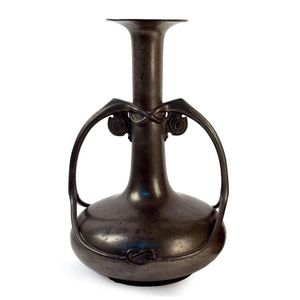
Tudric Art Nouveau Pewter Vase with Knot Motif
A Tudric pewter Art Nouveau vase, of circular shape with tall trumpet neck, two handles looped from mid-way on the neck and join the body in bifurcated tendrils which conjoin with an overhand knot motif. Impressed mark and No. 0214, attributed to…

 Loading more...
Loading more...